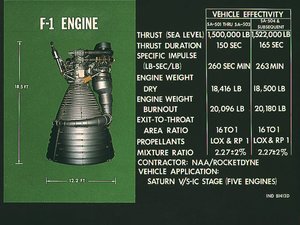F-1 (rocket engine)
|
|
- For other uses, see F1 (disambiguation).
| Contents |
History
The Rocketdyne-developed F-1 engine was the world's largest liquid fueled rocket engine. The F-1 was originally developed by Rocketdyne to meet a 1955 US Air Force requirement for a new very large rocket engine. The eventual result of that requirement was two different engines—the E-1 and the much larger F-1. The E-1, although successfully tested in static firing, was quickly seen as a technological dead-end and was abandoned for the larger and more powerful F-1. The USAF eventually halted research and development of the F-1 due to a perceived lack of requirement for such a large engine. However the recently created NASA realised the capability afforded by an engine with so much power and contracted Rocketdyne to complete the development of the F-1. The first static firing of a full stage developmental F-1 was performed in March 1959. (Earlier test firings of F-1 components had been performed as early as 1957.)
Early F-1 tests revealed serious combustion stability problems (mostly concerned with the design of the fuel injector plate) which led to a number of engine tests failing due to either engine flame-outs or rapid explosive combustion. These problems were addressed throughout 1959 and the next couple of years and eventually the engine's combustion was so stable that a bomb could be detonated inside a firing engine with no issues.
The F-1 burned two short tons (1.8 t) of liquid oxygen (LOX) and one ton (0.9 t) of RP-1 (kerosene) each second generating over 1.5 million pounds-force (6.7 meganewtons) of thrust. Five F-1 engines were used in the S-IC first stage of the U.S. Saturn V rocket. During their two and one-half minutes of operation, the 5 F-1s propelled the Saturn-V vehicle to a height of 52 km (32 miles) and a speed of 8,700 km/h (5,400 mi/h).
There were proposals to use eight F-1 engines on the first stage of the Nova rocket.
Original F-1 Specifications
Thrust (sea level): 1,500,000 lbf (6.7 MN)
Burn Time: 150 s
Specific Impulse: 260 lbf·s/lb (2.55 kN·s/kg)
Engine Weight - dry: 18,416 lb (8,353 kg)
Engine Weight - burnout: 20,096 lb (9,115 kg)
Height: 18.5 ft (5.6 m)
Diameter: 12.2 ft (3.7 m)
Ratio: 16 to 1
Propellants: LOX & RP-1
Mixture Ratio: 2.27
Contractor: NAA/Rocketdyne
Vehicle Application: Saturn V / S-IC 1st stage - 5-engines
F-1 Developments
There was an uprating redevelopment of the F-1 undertaken by Rocketdyne during the 1960s which resulted in a new engine specification known as the F-1A. While outwardly appearing to be very similar to the F-1, the F-1A was actually lighter and yet significantly more powerful (9.1 MN compared to F-1's 6.7 MN) and would have been used on future Saturn V vehicles in the post-Apollo era. However, the Saturn V production line was closed prior to the end of Project Apollo and no F-1A engine ever flew on a launch vehicle.
The F-1 engine remains the most powerful liquid fuel rocket engine ever developed at 6.7 MN of thrust. However among solid-fuel engines, more powerful engines exist such as the Space Shuttle Solid Rocket Boosters, which each boast a thrust of 14.7 MN.
External links
- E-1 at the Encyclopedia Astronautica (http://www.astronautix.com/engines/e1.htm)
- F-1 at the Encyclopedia Astronautica (http://www.astronautix.com/engines/f1.htm)
- F-1A at the Encyclopedia Astronautica (http://www.astronautix.com/engines/f1a.htm)
- NASA SP-4206 Stages to Saturn - the official NASA history of the Saturn launch vehicle (http://history.nasa.gov/SP-4206/sp4206.htm)

